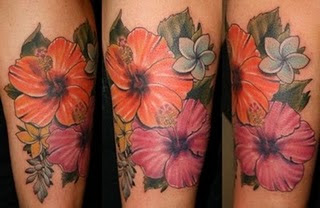
 The Peony is considered the best of flowers and is known as the King of flowers. In short it means elegance and wealth. With it’s large and spreading red petals, which are delicately curled at the edges, the peony has been called in Europe “the rose without thorns” and has been used at times as a way to refer to the Virgin Mary. But even from the time of the ancient Greeks, it has been associated with many positive folk medicine cures in the western world, treating ailments that range from asthma to epilepsy and even keeping evil spirits away. Although often depicted in tattoo imagery in deep red, it is today also cultivated in white, varying shades of red and even yellow. The principal association in tattoo work is not western but rather eastern, where flowers take on a distinctly different set of meanings.
The Peony is considered the best of flowers and is known as the King of flowers. In short it means elegance and wealth. With it’s large and spreading red petals, which are delicately curled at the edges, the peony has been called in Europe “the rose without thorns” and has been used at times as a way to refer to the Virgin Mary. But even from the time of the ancient Greeks, it has been associated with many positive folk medicine cures in the western world, treating ailments that range from asthma to epilepsy and even keeping evil spirits away. Although often depicted in tattoo imagery in deep red, it is today also cultivated in white, varying shades of red and even yellow. The principal association in tattoo work is not western but rather eastern, where flowers take on a distinctly different set of meanings.In the ornate, complex, and extensive body coverage that is typically involved in Japanese tattoos, it may seem as though entire gardens appear, but the floral repertoire of traditional Japanese tattoo is not as extensive as it might first appear. We can say that among the select flowers that are used is the peony, a flower with a very long history (as much as 4000 years) in China and then in Japan. For the Chinese it was regarded as a symbol of wealth, good fortune and prosperity. In Japanese culture, it symbolizes much the same. In addition though, since the peony is part of an old Japanese card game (historically played by heavily tattooed gamblers), it also suggests a sort of gambling, daring and even a masculine devil-may-care attitude, quite unlike its character in the west
No comments:
Post a Comment